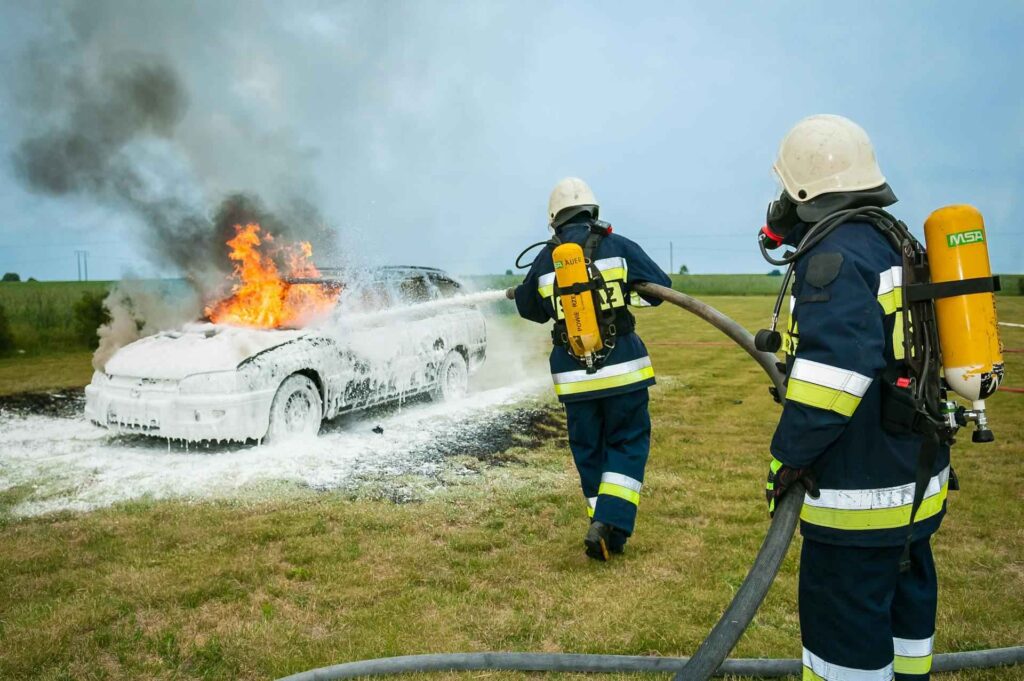Electric cars (EVs) are substantially less likely to catch fire than their gasoline-powered counterparts, according to a Guardian story. Many fires recorded for gasoline or diesel cars go unreported, according to Colin Walker, head of transportation at the Energy and Climate Intelligence Unit think tank.
This article examine the increase in electric cars fire, go over the safety risks and causes of these fires, and offer advice on how to keep safe.
- Major Cause of Electric Cars Fire
- How serious are Electric cars Fire
- Notable Electric Vehicle Fire Incidents
- Ways of Preventing Fires in Electric Vehicles
- Tips for maintaining EV batteries:
- Tips for safe charging of EV Batteries
- The Function of Standards and Regulations to Curb Electric Cars Fire
- The Increase in Demand for Electric Vehicles
- Conclusion
Data sets from a number of nations, including Australia, Norway, and Tesla’s global fleet, were assembled by The Guardian. The evidence is clear: EVs have a significantly lower fire risk than gasoline or diesel cars.
Elevated performance, lower operating costs, and lower pollutants have made electric cars (EVs) more and more popular. Concern over their safety, especially in light of electric cars fire, is, nevertheless, growing. There are regular reports of Electric cars fire, which happen occasionally. In contrast to vehicles powered by gasoline or diesel engines, this begs the question of how common electric cars fire occur and how likely they are.
Why, then, are reports of EV fire far higher than those of internal combustion engine-powered vehicles? Many reasons exist for this, some of which are obvious: for example, the fact that EVs are relatively new to the world’s roads, the fact that many people oppose electrification in general, and the fact that electric cars fire tend to be quite spectacular (and, yes, potentially more dangerous than other types of fires).
Major Cause of Electric Cars Fire
Various reasons can result in Electric cars fire, such as events involving batteries: EV fires are most frequently caused by events involving
- -Degradation of the battery, or incorrect use of battery,
-Manufacturing flaws may also be the cause of these accidents. - External influences: Electric cars fire can also be caused by outside sources, like craze,
- -Overcharging the battery cells, and
- -Extremely high temperatures.
How serious are Electric cars Fire
EV Fires can have devastating consequences. Electric cars fire are challenging to put out because of their strong heat output and quick spread. When EV batteries burn, they may also generate harmful toxins.
Safety Risks EV Batteries fire
Electric cars fire raise several fire hazards and safety issues, such as safety risks to emergency responders: EV fires pose special difficulties for emergency personnel. Hence, First emergency responders need to take extra care to prevent electrocution since EV lithium-ion battery fire can burn for hours after the fire has been put out.
Possible dangers to occupants: Electric cars fire have a strong heat output and a quick spread, which makes it challenging for people to flee. Furthermore, burning EV lithium-ion batteries can create toxic vapours that are extremely dangerous to one’s health.
Notable Electric Vehicle Fire Incidents
Norway Tesla Fire:
In 2013, a driver struck a metal object on the pavement, causing a Tesla Model S to catch fire. The car was completely destroyed by the rapidly spreading flames. After the incident was investigated, it was discovered that the metal object had broken through the battery pack and caused a short circuit. The battery was outblazed by the short, and the fire quickly spread to the rest of the car. While being charged at a supercharger, a Tesla Model S caught fire and burned.
India Ola Scooter Fire:
Several Ola electric scooters caught fire in India in 2022, resulting in multiple injuries and fatalities. It was determined that battery flaws were the root cause of the fires. According to the research, the impacted electric bike battery packs had a manufacturing flaw that might have caused them to overheat and catch on fire. After catching fire, the Ola S1 Pro
electric scooter is being investigated.
EV fire frequency in comparison to conventional car

There are fewer occurrences of reported electric cars fire compared to conventional gasoline-powered cars. However, as more EVs are driven, the number of Electric cars fire is expected to rise. With the few reported electric fire incidents, EV manufacturers are beginning to improve battery safety enhancements.
For instance, Tesla has since made various enhancements to its battery packs, including adding a safeguarding layer to shield the battery from harm. Ola has likewise done whatever it takes to work on the well-being of its bikes, like reviewing every single impacted vehicle and replacing the battery packs.
Ways of Preventing Fires in Electric Vehicles
EV fires can be avoided by taking a number of measures, such as:
–User obligations: It is the duty of EV owners to take precautions against fires. This entails being informed of the possible dangers connected with EV fires and following the manufacturer’s guidelines for battery care and charging.

–Producer efforts: EV Manufacturers are always trying to make their cars safer. This includes creating improved cooling systems and batteries with increased fire resistance.
–Keeping Yourself Safe When Around Electric Cars: To keep safe around EVs, both EV owners and the general public should adopt the following safety precautions:
–Precautions for EV owners’ safety: Know how to use and keep a fire extinguisher in your car. Prepare a strategy for getting out of the car in case of a fire. Recognize the possible hazards connected to electric vehicle fires and take precautions against them.
–Security protocols for the broader population: Know which EVs have been involved in collisions. An emblem designating an electric vehicle is usually located on the back of an EV.
-Avoid approaching an electric vehicle (EV) that has been involved in an accident or is on fire. Make a hotline call.
-General fire safety training.
Tips for maintaining EV batteries:
- Kindly inspect the battery for any indications of wear or damage.
- Make sure the battery is tidy and free of debris.
- Keep the battery away from extremely hot or cold temperatures.
- Observe the charging and storage guidelines provided by the manufacturer for your battery.
Tips for safe charging of EV Batteries
Make use of only authorized devices and charging stations.
Avoid excessive charging of the battery. While the battery is charged, keep an eye on it. When the battery is not in use, unplug it.
The Function of Standards and Regulations to Curb Electric Cars Fire
The safety of EVs is largely ensured by industry standards and governmental laws. Government initiatives and rules: To guarantee the safety of EVs, numerous countries are creating laws across the globe. For instance, the Indian government’s EV scheme; The FAME India Scheme, introduced in 2015, aims to promote the adoption and manufacturing of electric vehicles in India, focusing on the development of safe and effective vehicles.
The National Electric Vehicle Policy 2021 seeks to position India as a leader in the EV industry worldwide by fostering safety through the establishment of a national centre for testing and certification, the development of first responder training programs, and requirements for manufacturers to adhere to Indian safety standards.
In 2022, the Battery Swapping Policy was introduced with the goal of encouraging the adoption of battery-swapping technology in electric cars (EVs). In addition to creating safety guidelines for battery storage and transportation, Stations must also create operator training programs and follow Indian safety regulations.
The Indian government is focused on advancing the security of EVs. The drives and guidelines referenced above are a positive development to guarantee that EVs are okay for both drivers and travellers.
Safety Principles of the EV industry and consistency
The EV industry has also promoted a number of safety-advancing ideas. SAE Global, for example, has promoted a standard for the welfare of EV batteries. The Safety of Electric Vehicles in the Future. We may expect to see additional improvements in EV safety as EV innovation continues to accelerate. For example, researchers are creating new battery technologies that are more efficient and resistant. Moreover, EV manufacturers are creating additional security features, such as early warning. systems for battery fires.
Social viewpoints and education
It is also crucial how people see the welfare of electric vehicles. A primary obstacle to the widespread adoption of electric vehicles (EVs) is the ongoing anxiety that many people have about their safety. It is important to educate the public on the advantages and risks of electric vehicles. Additionally, EV owners should be aware of the safety precautions that can be taken for their own well-being.
The Increase in Demand for Electric Vehicles
The global EV market is expanding quickly, and by 2028, sales are predicted to reach over 30 million units. Numerous factors, such as government subsidies, falling EV battery costs, and growing consumer awareness of the environmental benefits of EVs, are contributing to this increase. In comparison to conventional gasoline-powered automobiles, EVs have a number of benefits, such as:
Decreased emissions: Since EVs have no tailpipe emissions, air quality is enhanced, and greenhouse gas emissions are decreased.
Enhanced performance: Because EVs generate torque instantly, they usually handle and accelerate more smoothly than gasoline-powered cars.
Reduced running costs: Since electricity is a far less expensive fuel than gasoline, EVs are less expensive to operate than gasoline-powered cars.
Conclusion
As electric cars (EVs) are growing in popularity, it is critical that owners and the general public are informed of the possible risks of fire. We can minimize danger and enhance the benefits of electric vehicles (EVs) by being aware of the causes, taking preventive action, and being ready for emergencies. All parties involved need to be on the lookout for changes in safety regulations and electric vehicle battery technology.
Kindly visit our Home Page for more related posts.



